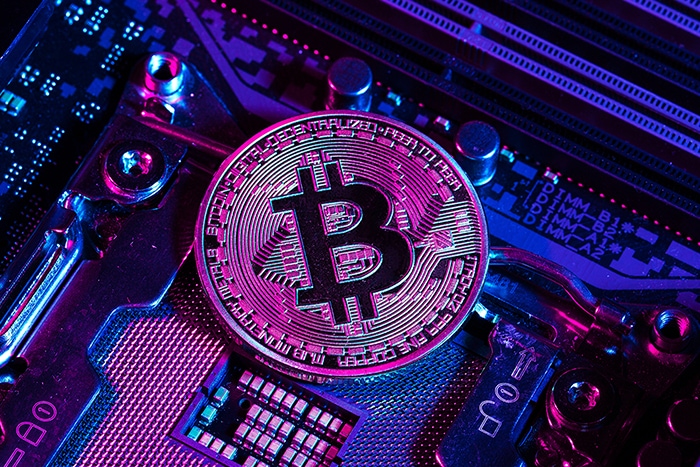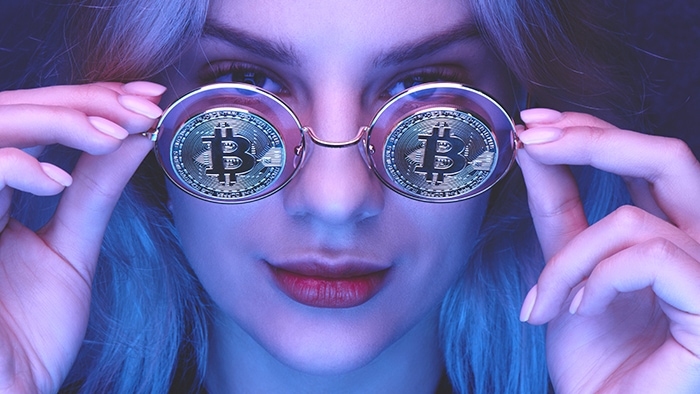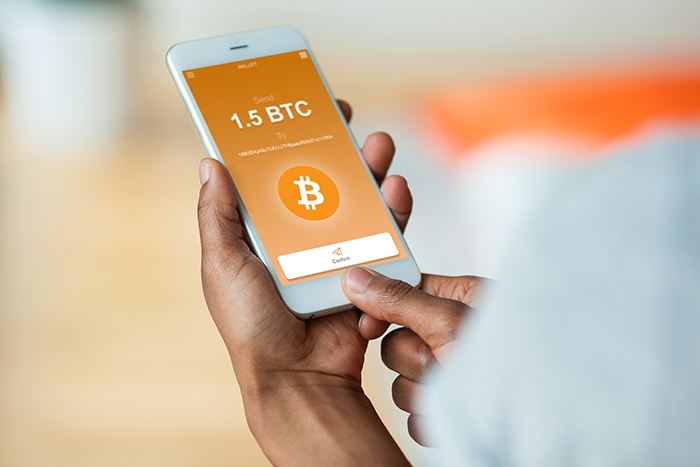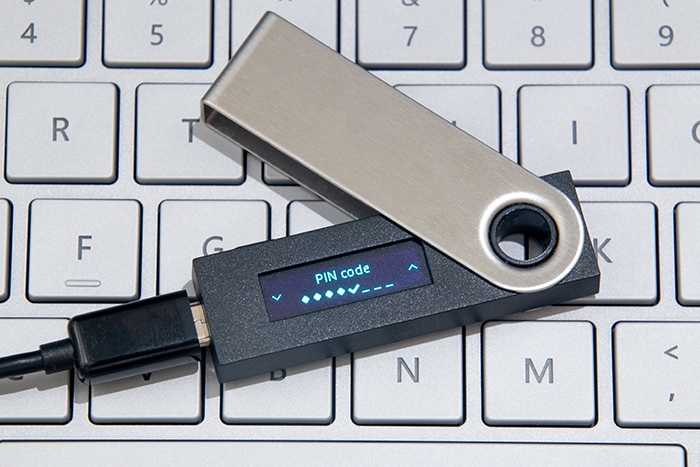The investing information provided on this page is for educational purposes only.
Unless you’re our Uncle Francis, you’ve likely heard of cryptocurrency. Odds are good that you have someone in your social network who’s bought some — maybe even your Uncle Francis! If they did it more than a few years ago, they’ve probably bragged about how their initial investment has doubled or quadrupled or whatever-comes-after-that.
If you’ve ever wondered “how do I buy Bitcoin (or another cryptocurrency),” it’s about as straightforward as buying stocks. But there’s some different terminology and you use different platforms. (And better memes.)
And while building a time machine to take us to 2019 hasn’t panned out (yet), we can still help you jump in on this crypto craze now, so in the future you can look back and say, “Yep, I bought cryptocurrency then.”
What You’ll Need to Buy Cryptocurrency:
- Money
- A computer or smartphone
- The ability to keep secrets
What Is Cryptocurrency?
Cryptocurrency is a decentralized digital currency, often referred to as crypto. It uses blockchain technology that tracks every transaction. The word itself comes from a combination of cryptography — because there’s a cryptographic signing of the transaction to verify identity — and currency.
Are All Cryptos the Same?
No. There are thousands of different cryptocurrencies and each has its own purpose on the blockchain. Here are just some of the use cases different coins and tokens may offer:
- Act as a store of wealth
- Smart contract functionality
- Data Feed / Oracle
- Decentralized banking, exchanges, and other financial instruments
- Insurance
- Gambling
- Gaming
- NFTs
- Privacy
- Memes
But, at this stage it’s nearly impossible to tell which cryptos will be the next Amazon or Google and which will be Netscape or Pets.com — of cryptos, anyway. The next Google of startups will be the company our brother founded that’s putting AI in the water supply!
Bitcoin
The largest and most popular cryptocurrency is Bitcoin. It was launched on January 3, 2009 by someone (or someones) under the nom de guerre Satoshi Nakamoto. But, while the concept and tech behind Bitcoin’s origins are interesting, they don’t have much real-world functionality. Kinda like Iron Man, if Iron Man was a guy in a robot suit who just literally ironed.
These days, Bitcoin is mostly used as a store of wealth, though, yes, you can use Bitcoin to buy a Tesla — should you feel the urge to go full-on Silicon Valley dbag. Even so, we don’t necessarily recommend this, as you could end up like Laszlo Hanyecz who traded 10,000 Bitcoin for two pizzas in 2010. Granted, at the time one Bitcoin was worth only about $0.0025, but he could’ve waited a couple years and used his virtual money to buy three pizzas.
Smart Contracts: Ethereum, Polkadot, and Cardano
Unlike Bitcoin, Ethereum is the primary transactional currency. It’s the blockchain used to buy other cryptos on, and to purchase NFTs (non-fungible tokens) on sites like Opensea or Rarible via what are called smart contracts. (That paper napkin agreement between you and your roommate about who gets to use the living room on Fridays is a dumb contract.)
But, Ethereum is not alone in this ability and we are likely to see real competition soon from Polkadot (DOT), Cardano (ADA), Solana, Avalanche, and so on.
🔮 Will we see a new #ETH all time high today? https://t.co/J531RCy19b pic.twitter.com/XvLyAv3mMs
— Kraken Exchange (@krakenfx) April 5, 2021
Alt Coins
Then, there are alt coins (technically everything that isn’t Bitcoin is an alt-coin) that are decentralized applications (Dapps) built on the Ethereum and Polkadot blockchains.
These include games like My Neighbor Alice, NFT hubs like Rarible, and Decentralized Finance (DeFi) applications like Uniswap or Compound Finance. Read this last sentence to anyone over 50 and watch them have an aneurysm in real-time.
This whole article isn’t investment advice, but also don’t recommend buying most alt coins as a starter investment, as they’re high-risk. Some alt coins are rug pulls, some are pump-and-dumps, some have no actual purpose (we see you there, Doge), and only a few are worthwhile projects that are still growing. We’d tell you which are which, but what’s the fun in that? Also, we don’t know.
If you’re interested in an alt coin, definitely DYOR (do your own research) which includes reading the whitepaper. This is essentially a high-level look at the team behind the project’s business plan and roadmap. Whatever you do, don’t buy something just because Elon Musk, a YouTuber, or, worst of all, Elon Musk on YouTube told you to.
Stablecoins
There are also cryptocurrencies that aren’t volatile known as stable coins. Some, like Tether (USDT) and USDC are pegged at a 1:1 ratio to the US Dollar. But don’t invest in a stable coin and expect it to go to the moon. Hey, we warned you about that Musk guy.
Why Is Cryptocurrency So Hot Right Now?
Because Elon Musk has been tweeting about Bitcoin? (Pretty sure that’s almost the last time we reference that weirdo in this post, pinky swear.) And, to be fair, Marc Cuban has been talking about DeFi and NFTs (and releasing some of his own).
Cryptocurrency is getting hyped as a unique and exciting investment vehicle, basically because it looks like a good way to make a lot of money, fast. And, if you know anything about people, you know they like doing lots of research, investing wisely, and being patient. JK! We all want to get rich quick.
Michael Saylor, the CEO of Microstrategy, explains it this way: “Bitcoin is a unique new technology. It’s like the Facebook of money or the Google of money.” He left out that it’s also like the Amazon of money, but you don’t get to be a CEO by wasting your time on the rule of three.
Anyway, think about putting some money in Bitcoin now as kind of like buying some Google stock when it was worth about $100, back when you were using your Benjamins on silly stuff like apartment rent and instant noodles — if only you’d forgone eating in 2004, you’d have way more instant noodles to eat today.
Of course, with Bitcoin you can also lose money, which is why we don’t recommend investing all your funds into crypto. Think of it as one way to diversify your investment portfolio, get ahead of the curve, have something to talk about on your office coffee calls, and maybe see some sweet, sweet gains.
Where to Buy Cryptocurrency
There are many ways to invest in crypto — from traditional investing and trading to staking and yield farming. But, if you’re looking to get started, let’s start with the first important step: buying it.
To start, we recommend buying your first crypto on a centralized exchange. There’s no risk that you’re buying a scammer’s version of a coin or that you’ll enter the wrong wallet address and then send your funds into the void and have them lost forever. We learned that lesson the hard way when we threw a piggy bank’s worth of change into a wishing well.
Exchanges allow you to swap one cryptocurrency for another or to use a fiat currency (USD, CAD, GBP, etc.) for cryptocurrency. Like snowflakes, every exchange is different; also like snowflakes, each has its pros and cons.
For example, Kraken allows you to buy Polkadot, and it also allows you to stake it and earn 12% APY in passive income. Coinbase, on the other hand, doesn’t have Polkadot, but it’s more user-friendly.
Once you’re familiar with the process, you can also purchase from a decentralized exchange like Pancake Swap or Uniswap. Gas fees (transaction fees) are higher, but individual coins are usually cheaper if they’re only on decentralized exchanges and often (though, not always) go up in price when they are added to centralized exchanges.
The major centralized exchanges in the US:
With the updated home screen in the Coinbase app, we’ve made it easier to follow and track assets; see how the markets are moving; check out the latest crypto news; and discover new ways to do more with crypto. Download the app today: https://t.co/pkB9BrB9ju pic.twitter.com/KIWXog2nm7
— Coinbase 🛡️ (@coinbase) February 12, 2020
How To Buy Bitcoin or Another Cryptocurrency on an Exchange
1. Sign Up for an Exchange
Using your private WiFi (or your parents’, provided their password isn’t “password”), create an account on the exchange of your choice.
Write down your master passphrase somewhere very secure that you won’t misplace. Good: a Post-It note you place in a small safe. Bad: a Post-It note you place on a live animal.
Set up two-factor authorization on your phone, and store the recovery code for that somewhere safe.
2. Add Funds
Depending on the exchange, you’ll need to send fiat (the money you’re used to) to the exchange.
- On Kraken, you can send it via wire transfer for around $30 per transfer, plus whatever fee your bank or credit union charges.
- On Coinbase, you can purchase crypto instantly, but you’ll have to wait up to a week to then sell or convert it. If you’re holding for a while, this is fine, but if the price moons and you want to sell (i.e., drops and you want out), you’ll have to wait out what could be a pretty stressful period.
You can also buy crypto using your Paypal account or a debit or credit card on a platform like CashApp, though you may be charged a cash-advance fee.
3. Buy Cryptocurrency
Once you’ve added fiat to the exchange, you can then use it to purchase Bitcoin, alt coins, or stablecoins. You also don’t have to own a full coin, for those of us who don’t have $59k to drop on one Bitcoin. Partial amounts are ok.
While 0.00017 of a Bitcoin might not seem like much, it’s 0.00017 more than nothing, which is what you’d have if you spent $10 on a kale smoothie instead.
You can swap from one currency to another and, like with most traditional stock trading platforms, you can sell crypto back to the exchange and purchase a different one, or pull your funds out of the market altogether.
The major exchanges simplify this process for those new to the market, but if you’re familiar with candles, charts, trading screens, or setting limit orders, you can use this section of their platforms as well. Just click on the “market” or “trade” button.
Just keep in mind that each transaction will incur a fee, and you’ll have to pay taxes on any of your earnings even if you’re “just swapping” coins or tokens. These fees can add up, so going in with a game plan and an exit strategy is always wise. We like to pretend our best friend is calling with an emergency — “Sorry, gotta go!”
4. Store It
When it comes to securing your crypto, it’s best to have a cryptocurrency wallet with full ownership. This means having access to the private keys. Private keys are encrypted information necessary to gain access to your crypto investment. That’s why they say, “Not your keys, not your coins.” Who says this, you ask? Other people.
When you’re using exchanges like Coinbase or Kraken, these organizations have the private keys. You can store your crypto there, but the balance is not federally insured, even if they each have strong security features. Still, if they’re hacked, you risk losing your funds.
If you don’t feel comfortable storing your coins on the exchange, you can also move them to a wallet. When you want to sell or exchange them for other coins, you’ll then transfer them back to the exchange.
Using a wallet means you have complete control over your account. But, if you lose your seed phrase, you lose access to your crypto. Forever. And, if anyone else gets it, they can access your funds.
Types of Wallets
- Hot Wallet – an application or software you can download onto your desktop or phone that provides easy accessibility to your cryptofunds. It’s the least secure as it is connected to the internet via your phone or web browser. Metamask is one of the most popular.
- Cold Wallet — Cold wallets are totally offline. These wallets usually look like USB devices that can be plugged into your desktop and are generally more secure than a hot wallet. Popular cold wallets include Trezor and Ledger.
- Paper Wallet – A paper wallet is a printed piece of paper that contains keys or a QR code. It sounds secure until you accidentally wash one with your laundry. Better if someone laminates it or prints it for you (we don’t expect you to be able to do these things yourself). If you like this, take it a step further and stamp the keys onto steel, cut the sheet into multiple pieces, and store the chunks in safe deposit boxes at separate banks. Thank you for planning our next escape room mission!
- POAPs: The Next Hot Trend in NFTs - November 29, 2021
- The 8 Biggest Crypto Investing Mistakes - August 2, 2021
- How to Buy Cryptocurrency: A Beginner’s Guide - April 7, 2021











All the exchanges listed above are centralized so which one is decentralized exchanges?